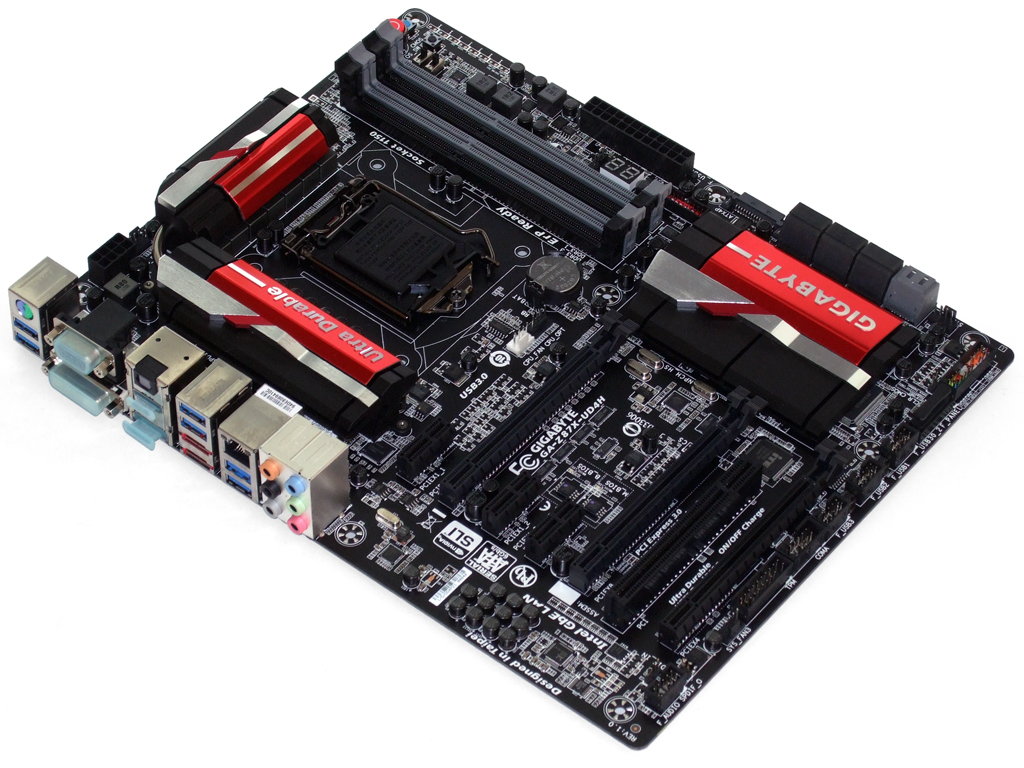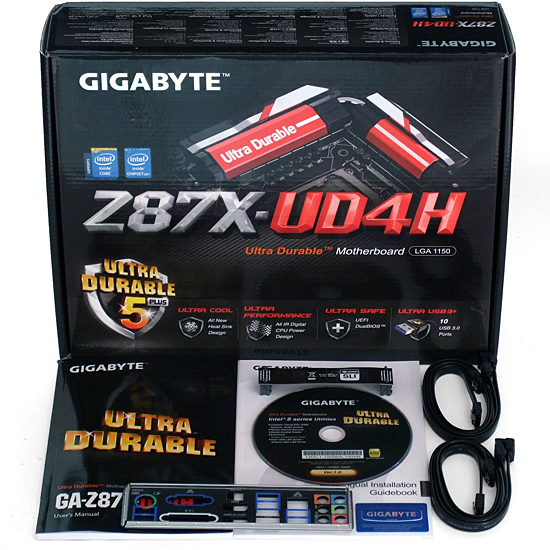Five Z87 Motherboards Under $220, Reviewed
Intel’s Haswell architecture displaces Ivy Bridge in its desktop line-up, bringing with it yet another new CPU interface. We tested six motherboards that claimed to be ready for your overclocking efforts, and included the five survivors in today’s review.
Gigabyte Z87X-UD4H
Why you can trust Tom's Hardware
In the balance between quality and features, Gigabyte’s $200 Z87X-UD4H appears to favor the former while still addressing the latter. We still find, for example, four extra USB 3.0 and four extra SATA ports split between internal and external connectors, but only two of those added-on SATA ports can be activated simultaneously.
The I/O panel also features separate VGA and DVI-D connectors, rather than using a DVI-I adapter block, in addition to the expected HDMI and DisplayPort outputs.
Similar compromises are found atop the board, from its older-but-adequate ALC898 audio codec to its four-lane PCIe 2.0 bottom slot. Using the chipset's PCIe connectivity for the bottom slot lets you drop in a card without stealing lanes from the graphics slots, but also makes the slot unsuitably slow for three-way CrossFire. And many builders are probably better-off treating it as an x1 slot, since enabling four-lane transfers requires the middle two x1 slots to be disabled.
Of course, one of those x1 slots will probably be covered by a graphics card anyway, since most of us favor powerful graphics engines.
Gigabyte shoves the Z87X-UD4H fairly hard towards the overclocking market with top-mounted power and reset buttons, a CLR_CMOS button, two BIOS switches, a POST code LED display, and a row of voltage rail detection points. The BIOS switches select single or dual BIOS mode, and which MOS is primary.
The company is still a bit proponent of its dual-BIOS functionality, and Gigabyte continues to do well with this technology. Anecdotally, though, I still remember the old days of swearing at the dual BIOS system, when a missed boot would cause the old backup ROM to overwrite the new one, when the old firmware wasn’t compatible with a new CPU. Recent improvements include a an automated request to update the backup MOS after rebooting from a primary MOS update, but users can still turn the feature off if desired.
Our only layout concerns are that owners of poorly-designed cases might have some difficulty getting their front-panel audio cables to reach the Z87X-UD4H’s bottom-rear corner header, and that its second USB 3.0 port is located too close to the third x16-length slot. If we pretend that bottom slot is incompatible rather than unworthy of a high-end graphics card, our second concern goes away.
The Z87X-UD4H installation kit is fairly basic, including only four SATA cables with an I/O plate and SLI bridge.
Current page: Gigabyte Z87X-UD4H
Prev Page Z87H3-A2X Extreme Applications Next Page Z87X-UD4H FirmwareGet Tom's Hardware's best news and in-depth reviews, straight to your inbox.
-
Someone Somewhere Who did you get the CPU from? Given the Haswell launch article said they were unlikely to be able to hit 4.5GHz+, is this a cherry-picked chip from Intel?Reply
Could we see some MBs around the $130-$140 mark? They're the interesting ones IMO, and would toast most of these in terms of value. -
Crashman Reply
Intel says it doesn't cherry-pick chips for reviewers...10911132 said:Who did you get the CPU from? Given the Haswell launch article said they were unlikely to be able to hit 4.5GHz+, is this a cherry-picked chip from Intel?
-
Memnarchon Thank you. I was looking forward for a review like this. I read some reviews and the o/c was varying from mobo to mobo lot. So if the same cpu was used, 4,3Ghz to 4,7Ghz is a lot of difference. Because if your cpu would o/c to 4,3Ghz most we would tell its a crap sample Haswell sucks on o/c etc etc, but if it was be able to clock to 4,7Ghz we would say its a nice sample.Reply -
cangelini Reply
Yes, the CPU comes from Intel. Almost certainly it was cherry-picked. But this is why we didn't rely on these CPUs for our launch coverage--it makes a lot more sense to go to a source with hundreds of boxed processors on the bench to get a real sense for what Haswell will do in the wild. At least for this round-up, the variable changing is the motherboard. So, we derive as much meaning as possible with a review sample that hits 4.7 GHz on one board and 4.5 GHz on another.10911132 said:Who did you get the CPU from? Given the Haswell launch article said they were unlikely to be able to hit 4.5GHz+, is this a cherry-picked chip from Intel?
Could we see some MBs around the $130-$140 mark? They're the interesting ones IMO, and would toast most of these in terms of value.
-
Someone Somewhere Yeah - but if people think that their chip is going to hit 4.7 on a good board, then find they can't get 4.5, they can be upset.Reply
OTOH, the launch coverage said that was at 1.2V, while this is 1.3V, so I guess a few hundred MHz extra is reasonable.
Lot more variation than on IB's review: http://media.bestofmicro.com/X/O/335580/original/image019.png -
JOSHSKORN Isn't there a flaw in the Z87 technology regarding sleep mode? Was it mentioned in the article? I didn't see it.Reply -
Jason Louie do these board suffer from the rumoured usb3 sleep issue? or are they the fixed B3 steppings ?Reply -
Crashman Reply
Did you read the Haswell review? All current boards are affected, no future boards will be, there's nothing to update here, and the flaw is virtually meaningless.10911218 said:Isn't there a flaw in the Z87 technology regarding sleep mode? Was it mentioned in the article? I didn't see it.
http://www.tomshardware.com/reviews/core-i7-4770k-haswell-review,3521-9.html
If you have one of the affected drives and can't be bothered to reconnect it when it goes offline, wait a couple weeks and buy a board from the new batch.
The differences between boards in today's review are overclocking, power consumption, and onboard features. None of those things will change with the new PCH batch, and firmware updates should improve both batches equally.
-
Jason Louie do these board suffer from the rumoured usb3 sleep issue? or are they the fixed B3 steppings ?Reply -
sna Hello,Reply
Can you guys please test 6 SSD in Raid 0 on these mobos ? this is the only Advantage of upgrading to a Haswell over ivy/sandy bridge.



